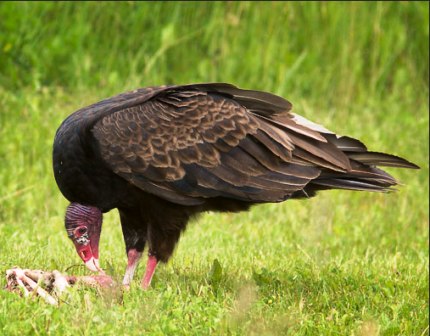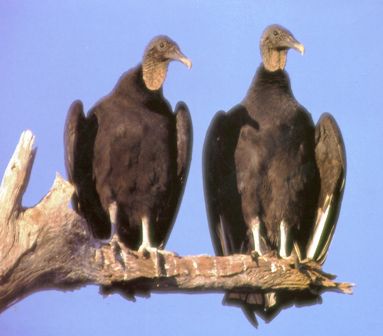Florida Vultures
One common fixture in Floridian nature is vultures or buzzards. Although it has an ugly, bare-skinned face, the Turkey Vulture is
beautiful on the wing. Seldom does this graceful and talented bird flap
its wings as it soars over large areas searching for carrion. The Turkey
Vulture uses its sense of smell to locate carrion. The part of its
brain responsible for processing smells is particularly large, compared
to other birds. Its heightened ability to detect odors allows it to find
dead animals below a forest canopy. The Turkey Vulture roost in a large
group, but usually forages alone, unlike its smaller, more social
relative, the Black Vulture. Although one Turkey Vulture can dominate a
single Black Vulture at a carcass, usually such a large number of Black
Vultures appear that they can overwhelm a solitary Turkey Vulture and
take most of the food.
The Turkey Vulture is a large bird. It has a wingspan of 67–72 inches, a length of 25–32 inches, and weighs between two and six pounds. Turkey vultures have dark brown to black plumage; a featherless, purplish-red head and neck; and a short, hooked, ivory-colored beak. The adult turkey vulture's head is small in proportion to its body and is red in color with few to no feathers. It also has a relatively short, hooked, ivory-colored beak. The irises of the eyes are gray-brown; legs and feet are pink-skinned, although typically stained white. The turkey vulture's eye has a single incomplete row of eyelashes on the upper lid and two rows on the lower lid. Its life expectancy in the wild ranges upward of 16 years, with a captive life span of over 20 years being possible.
The Turkey Vulture is a large bird. It has a wingspan of 67–72 inches, a length of 25–32 inches, and weighs between two and six pounds. Turkey vultures have dark brown to black plumage; a featherless, purplish-red head and neck; and a short, hooked, ivory-colored beak. The adult turkey vulture's head is small in proportion to its body and is red in color with few to no feathers. It also has a relatively short, hooked, ivory-colored beak. The irises of the eyes are gray-brown; legs and feet are pink-skinned, although typically stained white. The turkey vulture's eye has a single incomplete row of eyelashes on the upper lid and two rows on the lower lid. Its life expectancy in the wild ranges upward of 16 years, with a captive life span of over 20 years being possible.
The more southern of our two common vulture species, the Black Vulture
flaps its wings rather frequently while it soars. It is more social than
the Turkey Vulture, often traveling in large flocks. Like the Turkey
Vulture, the Black Vulture’s numbers are increasing and its range is
expanding northward in response to global climate changes. These
vultures are found in lowland areas along rivers or in open habitats in
the southern United States and throughout Central and South America.
They rarely inhabit dense forests. The Black Vulture has adapted well to
human habitats and can be seen at garbage dumps, markets, and fishing
docks. Vultures eat carrion in the form of road-kills or dead cattle in
pastures. Black vultures are more aggressive and may occasionally kill
or injure lambs, calves, cows giving birth, or other incapacitated
livestock. These birds soar looking for carcasses or other scavenger
activity.



Comments
Post a Comment